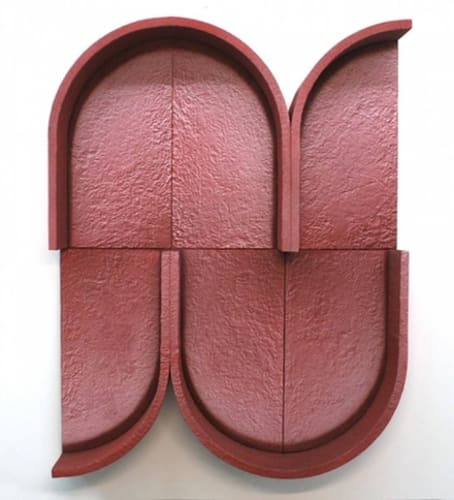Los Angeles based artist Amir Nikravan has taken a singular, pill-like form he encountered in Pasadena’s Stuart Building—a site originally known as the Stuart Pharmaceutical Company Office and Plant (1958)—and he’s given it a treatment of rupture and reconfiguration for Rational Design, his first solo show at Karg Gallery. Nikravan’s process is interesting; he begins by creating a ghost image in soft gradients of an underlying structure, which he later discards (so the audience never sees). Those imprints are made in acrylic, either on fabric or canvas, and then stretched over plaster and wood. For Rational Design, these forms are newly ensconced in smooth, matte curves, shedding the illusionistic three-dimensionality of his earlier work for actual depth.
Simultaneously paintings and sculptures, each hangs and protrudes from the wall, or rests on black plexiglass enclosures that look like empty media consoles, which he calls “Modernist Closets.” Through various physical and color rotations, the artist explores a necessarily in-between set of relationships, creating an interplay between the mechanized and the manual, interior and exterior, and textures both rough and smooth. Depending on where you stand, you can observe the textures slipping from a rough, stippled concrete into that of a wrinkled gym mat.
The best examples of the work, Rational Design (Purple Pill) and (Reuptake Inhibitor), sit on the pedestals and when observed from behind, achieve a wholly different effect. Like flattened, floating Ellsworth Kelly surfaces or Baldessari cutouts, the shapes obscure the inner workings found on the other side. The finishes envelop and reconcile all of the contradictions within the same object. They seem to exist in a temporary, tidy equilibrium, which doesn’t collapse upon circling the objects because they are kept separate and appear seductive approached either way. There is no wrong way to look at these works.
Nikravan’s titles (e.g. Rational Design (Indigestion), (Artery), and (Leak)) seem to conflate “painting’s pictorial illusionism and sculpture’s anthropomorphic presence” à la Judd.1 Whether these titles are his response to the objects, or are there to (mis)lead the viewer, collectively they evoke a not-so-tidy story of bodily functions. The pharmacological oval starts off as the blue pill, Rational Design (Pre-Exposure), which immediately confuses the subject-object relationship—whose exposure, and to what is unclear. The Rational Designs that aren’t enclosed arrangements have intakes and outputs that suggest a partial system of pipes, where this unnamed drug flows through a process of metabolism, circulation, absorption, and elimination.
For explanations, the temptation is to consult the brief essay by Alan Ruiz, Non-Representational Things, which accompanies the exhibition. In it, Ruiz suggests that the artist creates “unstable forms that trouble the ideal of Modernist purity” by making the shape perform and thereby “[m]anufacturing difference within standardization.”2 It is a queering of the reappropriated ornament from the Stuart’s Persian-inflected design, and—one gathers by delving deeper into the essay—against the erasure of both alterity and markers of the East.
Although framed as a reaction against the Stuart’s architect, Edward Durell Stone, this anxiety against imposed normality may have inadvertently led Nikravan to his patron saint. Stone, an early evangelist of the International Style, thanks to the 1932 Modern Architecture: International Exhibition at MoMA, became the eventual architect, along with Philip Goodwin, of the museum’s famous main building. It is also Stone, however, who abandons Modernist purity and its minimalist orthodoxy postwar and initiates The New Formalism with his US Embassy design in New Delhi (1954), for which he was derided for years by contemporaries, architectural critics, and scholars alike. In one of many attempts to rehabilitate the architect’s legacy, his son, Hicks, describes Stone’s “principal offense” as reintroducing classical elements and ornamentation into architecture, “an approach that was anathema to the tenets of International Style modernism.”3 More specifically, accusations of commercialism, populism, and kitsch were hurled at his creations, the worst insults reserved for his anti-MoMA at 2 Columbus Circle, famously and forever normalized after its 2005 renovation.
Modernism ate one of its own and seems to have swallowed Nikravan whole as well. As opposed to Baldessari’s “closet formalist,” Nikravan is an out-and-out formalist whose work functions delicately between an effort to out-modern Modernism and give it back a political purpose at the same time. The danger for Nikravan is that in his concern for clean execution, he risks emptying the signifiers he sought to preserve, manufacturing standardization through only slight deviations instead of thoroughly embracing the kind of excessiveness that would make these “things” truly unfamiliar, especially in the context of contemporary art. Indeed, they beckon to be considered normal. Unlike Kelly’s or Baldessari’s tremulous forms, or even Stone’s original pill, Nikravan’s Rational Designs are a too perfect distillation that’s too close to Modernist purity, nullifying the supposed critique. There is no wrong way to look at these beautiful works, but that’s not necessarily a good thing.


